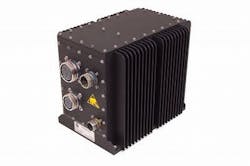BAE Systems chooses embedded computing from GE for embedded training on Bradley Fighting Vehicle
Editor's note: GE Intelligent Platforms changed its name to Abaco Systems on 23 Nov. 2015 as a result of the company's acquisition last September by New York-based private equity firm Veritas Capital.
WASHINGTON, 15 Oct. 2014.WASHINGTON, 15 Oct. 2014 Vetronics designers at the BAE Systems Platforms and Services segment in Santa Clara, Calif., needed rugged computers for embedded training capability on the U.S. Army BAE Systems M2A3 Bradley Fighting Vehicle. They found their solution from GE Intelligent Platforms in Huntsville, Ala.
GE has received a $2.6 million order from BAE Systems for the CRS-D5I-3VC1 rugged COTS system, which has GE's latest-generation 3U VPX COTS embedded computing boards for high-performance embedded computing (HPEC) aboard the Bradley.
The CRS-D5I-3VC1 COTS rugged systems will be deployed as part of the Army's Common Embedded Training Unit (CETU) for in-vehicle training and simulation aboard the Bradley. GE announced the contract win this week at the Association of the U.S. Army (AUSA) conference and trade show in Washington.
Related: Rugged vetronics embedded computer and smart display offered by General Dynamics Canada
The GE CRS-D5I-3VC1 rugged embedded computing system offers small size, weight and power (SWaP) to provide the functionality necessary for embedded training on the Bradley vehicle.
Embedded training involves simulation, training, and mission-rehearsal capability that enables Bradley crews to practice tasks like driving, ammunition loading, target acquisition and tracking, and weapons firing inside the actual Bradley Fighting Vehicle.
Embedded training enables crews to practice on their vehicles, rather than traveling to large and expensive full-mission computer simulators that are located at a limited number of locations. Embedded training especially is useful for warfighters deployed overseas where simulation capability is limited.
Related: BAE Systems chooses embedded computing from Curtiss-Wright for Bradley vetronics
The GE CRS-D5I-3VC1 is housed in a rugged, five-slot enclosure with a GE 3U VPX single board computer with an Intel Core i7 processor and a rugged graphics board based on the NVIDIA 384-core 'Kepler' graphics processing unit (GPU).
GPU technology enables embedded computing designers to use massively parallel processing that enables complex applications like embedded simulation and training in small, power-efficient spaces. The CRS-D5I-3VC1 rugged COTS system on which the CETU product is based is a packaged, pre-validated five-slot video processing, display and control computer system, GE officials say.
The system is designed for deployment in civilian and military unmanned vehicles, manned commercial and military aircraft, ground combat vehicles, helicopters, over- and underwater research vessels and railway locomotives. Typical applications include 360-degree situational awareness, embedded training, radar and sonar processing and hyper-spectral analysis.
Related: Rugged embedded computer for vetronics and shipboard electronics introduced by Comark
"Many defense organizations are looking for a solution that minimizes cost, reduces program risk and delivers proven performance and reliability," says Chris Lever, general manager of military & aerospace products at GE Intelligent Platforms. "Beyond these criteria, they are looking for immediate availability to shorten time to deployment. The CRS-D5I delivers on all these requirements."
For more information contact GE Intelligent Platforms online at www.defense.ge-ip.com, or BAE Systems Platforms and Services at www.baesystems.com.

